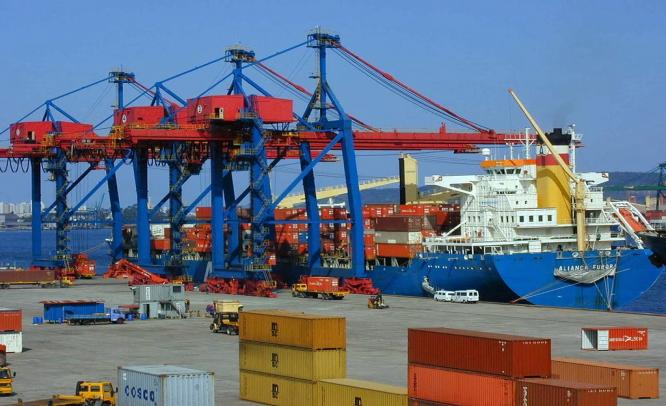Exports in January fell 26.6 percent compared to December, 2013 while imports rose 5.4 percent to push the country’s negative trade balance to an all-time high, reports Team IFM
Sao Paolo, August 6: The week’s onset struck Brazil a double whammy – the country’s exports in January, 2014 fell drastically compared to December 2013 taking the country’s trade balance to an all-time high deficit while factory output in December, 2013 over November, 2013 too shrank beyond expectations, official data showed.
Exports in January plummeted 26.6 percent to $16.03 billion from $20.85 billion in December, 2013, while imports at $20.08 billion rose 5.4 percent from $18.19 billion in December, 2013 resulting in a trade deficit of $4.06 billion, Brazil’s Ministry of Development, Industry and Foreign Trade reported on Monday. This was the country’s highest negative trade balance on record that goaded a Goldman Sachs analyst to question the central bank’s handling of its exchange rates.
A day later, Brazil’s statistics agency IBGE said the country’s industrial production had dipped 3.5 per cent during December, 2013 compared to the previous month, on the back of slackening domestic and global demand. This was the second month of contraction.
The magnitude of the fall in production figures was unforeseen; for instance, a Reuters’ panel of 24 economists had predicted an output drop of only 1.5 per cent, less than half of the actual figure. In general, forecasts had ranged from a 0.1 per cent increase to a 3 per cent decrease.
Even more interesting, the HSBC Purchasing Managers’ Index (PMI) for December had indicated an expansion in the South American nation’s manufacturing sector. In a statement released on January 2, HSBC said: “Brazil’s manufacturing economy expanded in December, with stronger production growth and renewed gains of new work pushing the PMI back into expansion territory.”
Dismal Deficit
But the gloomiest news coming out of Rio de Janeiro, where IBGE is located, related to Brazil’s dismal trade deficit figures. The marginal rise in exports in January, 2014 when compared to January, 2013 was found to be just too inadequate to offset import costs of consumer and capital goods, resulting in the highest trade deficit on record at $4.06 billion.
Exports of raw materials rose by an annual 5.3 per cent due to a surge in crude oil shipments (up 135 per cent year-on-year to $1.1 billion), soybean increased 49 per cent and that of live cattle by 36 per cent.
In comparison, exports of semi-manufactured goods fell 5.8 per cent, mainly due to lower sales of cast iron (down 43.1 per cent), gold (down 42.6 per cent) and aluminium (down 39.5 per cent).
Overall shipments of manufactured goods to various parts of the world shrank 2.6 per cent, the IBGE data showed. Exports to Eastern Europe fell 25 per cent; to Africa by 18.3 per cent; to West Asia by 14.5 per cent and that to the Mercosul – the South American trading bloc – and the EU by 6.2 and 5 per cent, respectively.
On the other hand, exports to Asia went up 17.4 per cent, the leg-up coming from a 27.7 per cent rise in shipments to China. So much so, China became Brazil’s top trade partner in the first month of 2014, accounting for 13.5 per cent of total exports and 19.9 per cent of total imports.
Exports to the US also surged by 11.4 per cent.
Brazil’s overall imports in January went up 5.4 per cent from December to $20 billion; this was also a 0.4 per cent increase year-on-year. Reflecting the thirst of the average Brazilian for foreign products, consumer goods imports rose by an annual 8.8 per cent, while capital goods went up 7.1 per cent. However, purchases of fuels and lubricants fell 19 per cent.
Tough times had been signalled last year itself: Brazil posted its smallest trade surplus in more than a decade in 2013.
Alberto Ramos, an economist with Goldman Sachs, squarely faults the country’s handling of the exchange rates for the January trade deficit. “It is symptomatic of an exchange rate that is still significantly misaligned,” Ramos told Financial Times.
The London paper quoted him as saying that the fair value for the real, the Brazilian currency, should be R$2.90-R$3 to the dollar but that even an adjustment to R$2.60-R$2.70 would make it competitive. On Wednesday, the value was about R$2.41 to the dollar.
In the past, the Brazilian government has been held guilty of intervening to controlling prices of fuel, energy and other commodities well as the exchange rate.
His formula: “Don’t use the exchange rate to control inflation, don’t use administered prices to control inflation, use the proper instrument for the proper problem,” Ramos told Financial Times, indicating interest rates were the correct way to tackle the issue.
Factory Output
On Monday, official statistics organisation IBGE or the Instituto Brasileiro de Geografia e Estatística said the country’s industrial production decreased 2.3 per cent in December compared to the same month in 2012.
Manufacturing output averaged 2.53 per cent from 1992 until 2013, reaching an all-time high of 20.12 per cent in March of 2010 and a record low of -17.47 per cent in January of 2009. (In Brazil, industrial production measures the output of businesses integrated in industrial sector of the economy such as manufacturing, mining, and utilities).
Most analysts failed to foresee the extent of the fall, and the median estimate of 24 analysts in a Reuters survey put the output decline at 1.5 per cent, while HSBC in a January 2 statement said manufacturing economy expanded in December, and identified consumer goods as the best performing sub-sector.
“Economic activity in the manufacturing sector expanded on the back of stronger production growth, with firms signalling the first month-on-month increase in new orders in six months,” HSBC Brazil Chief Economist Andre Loes said in the statement.

